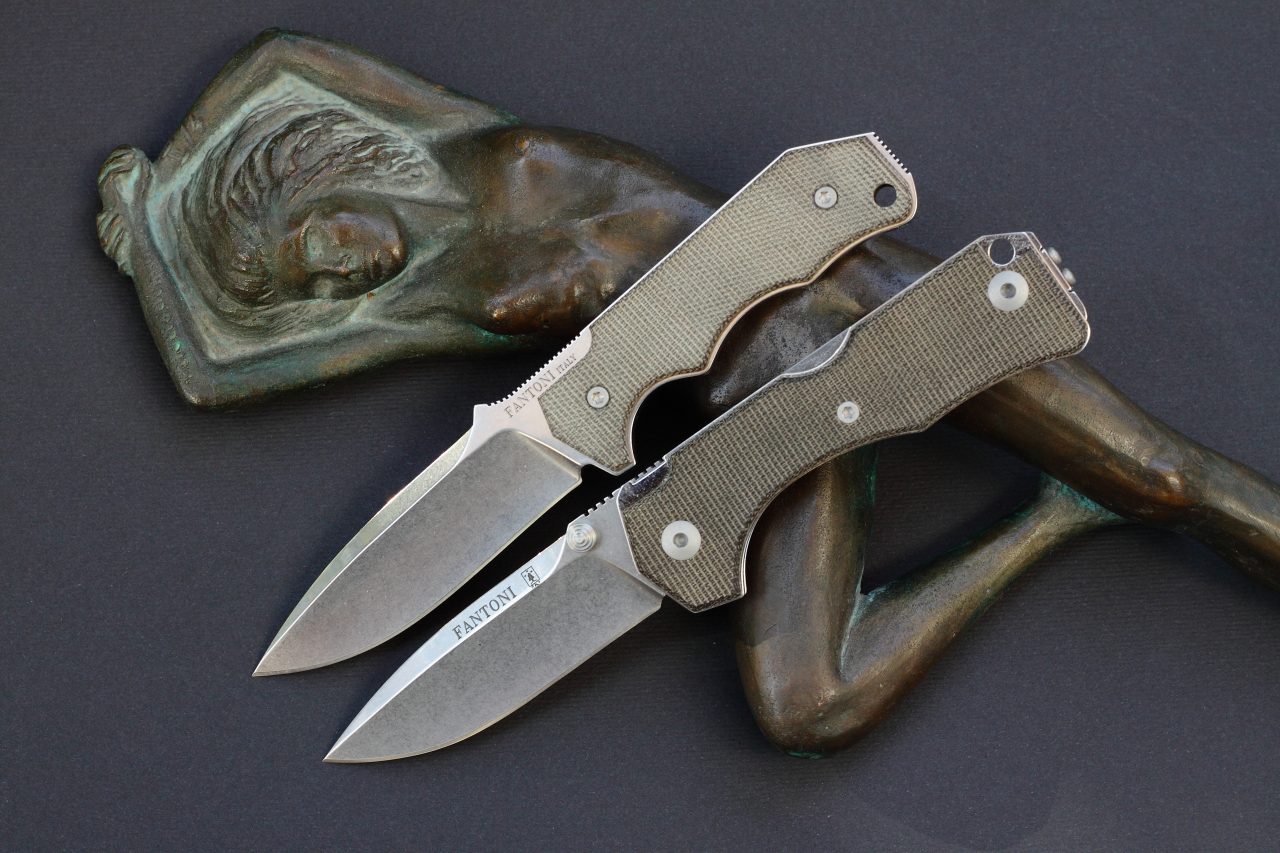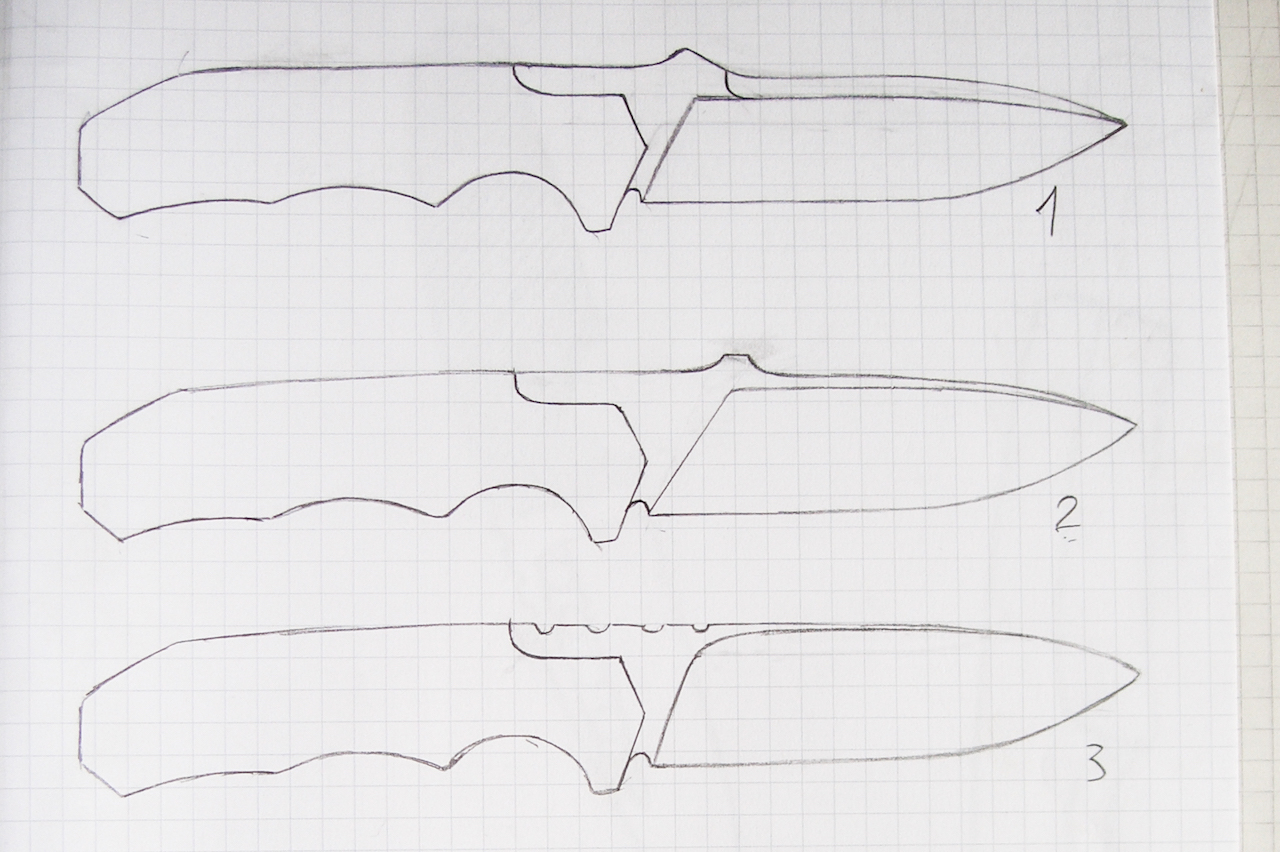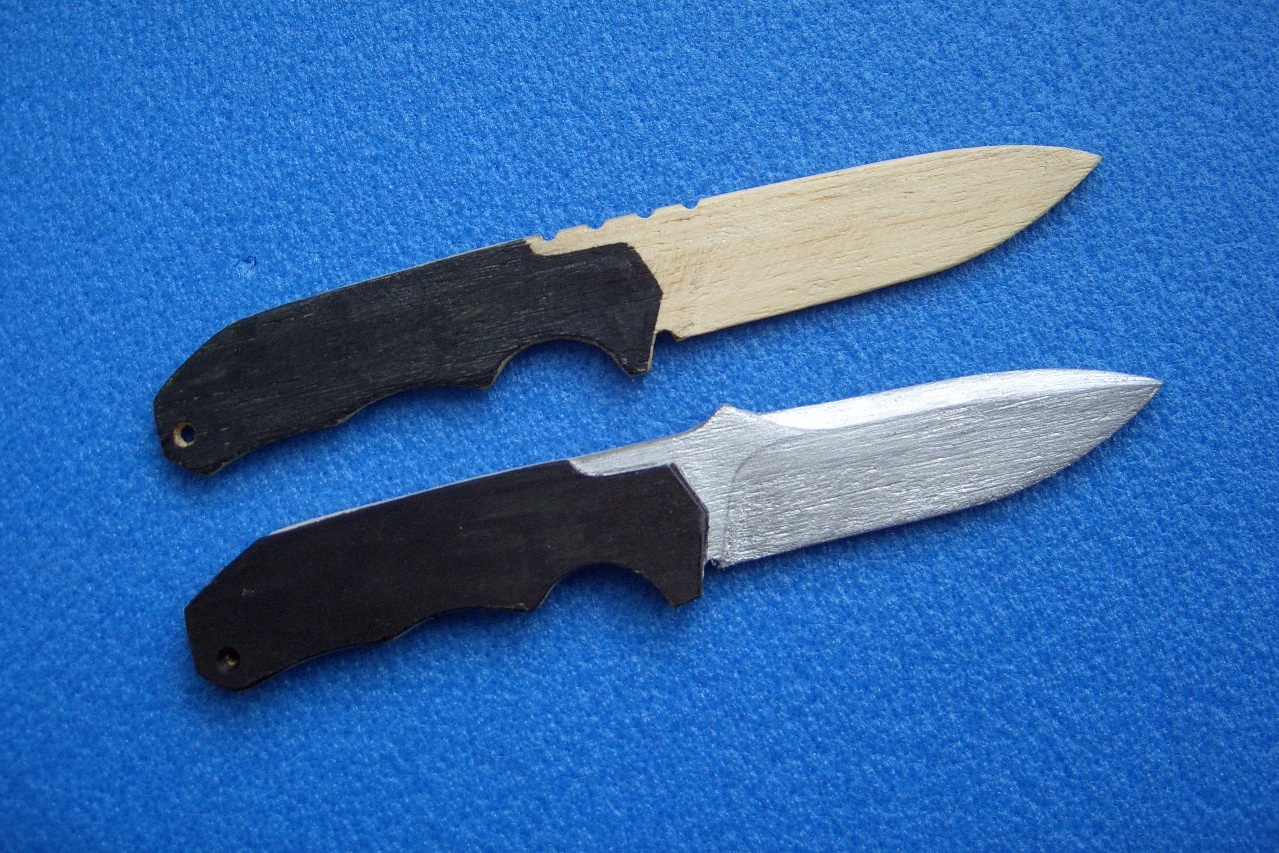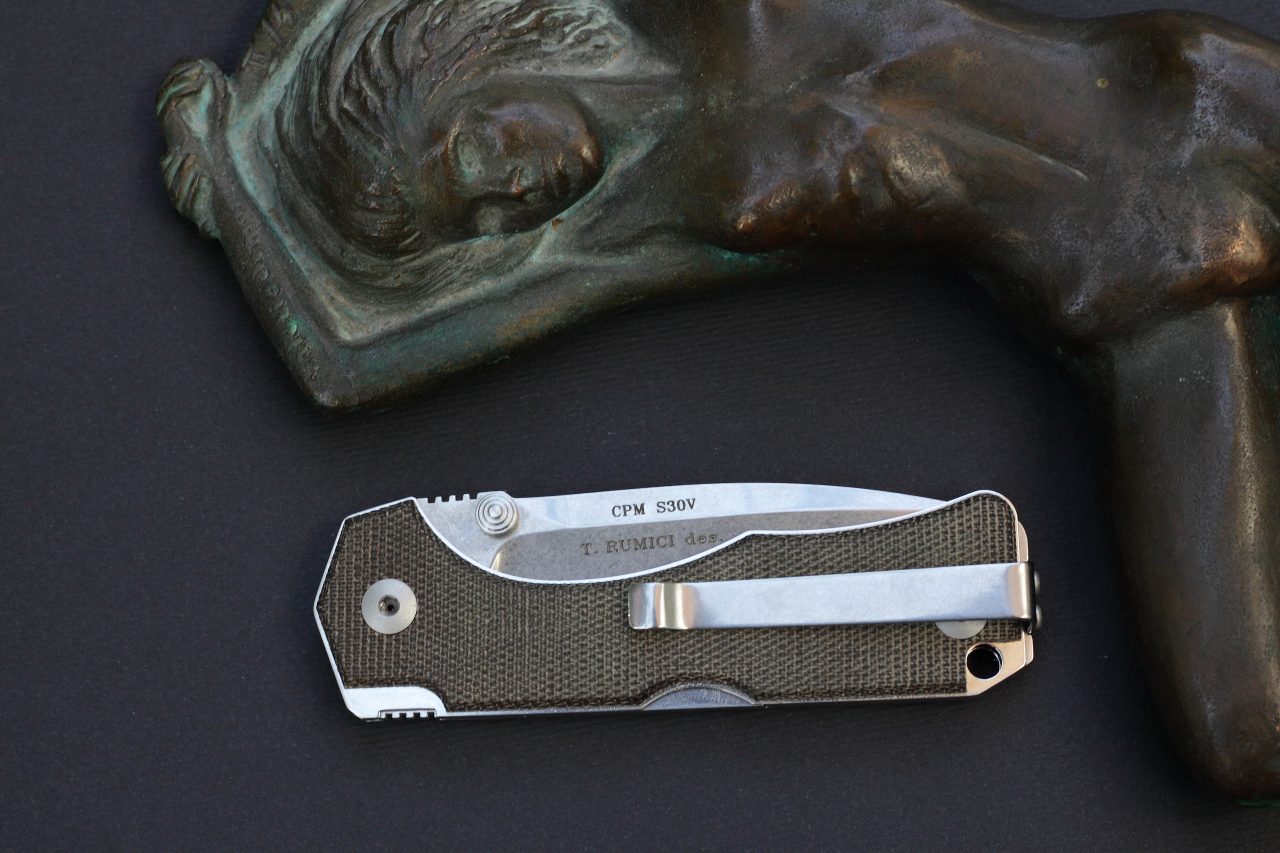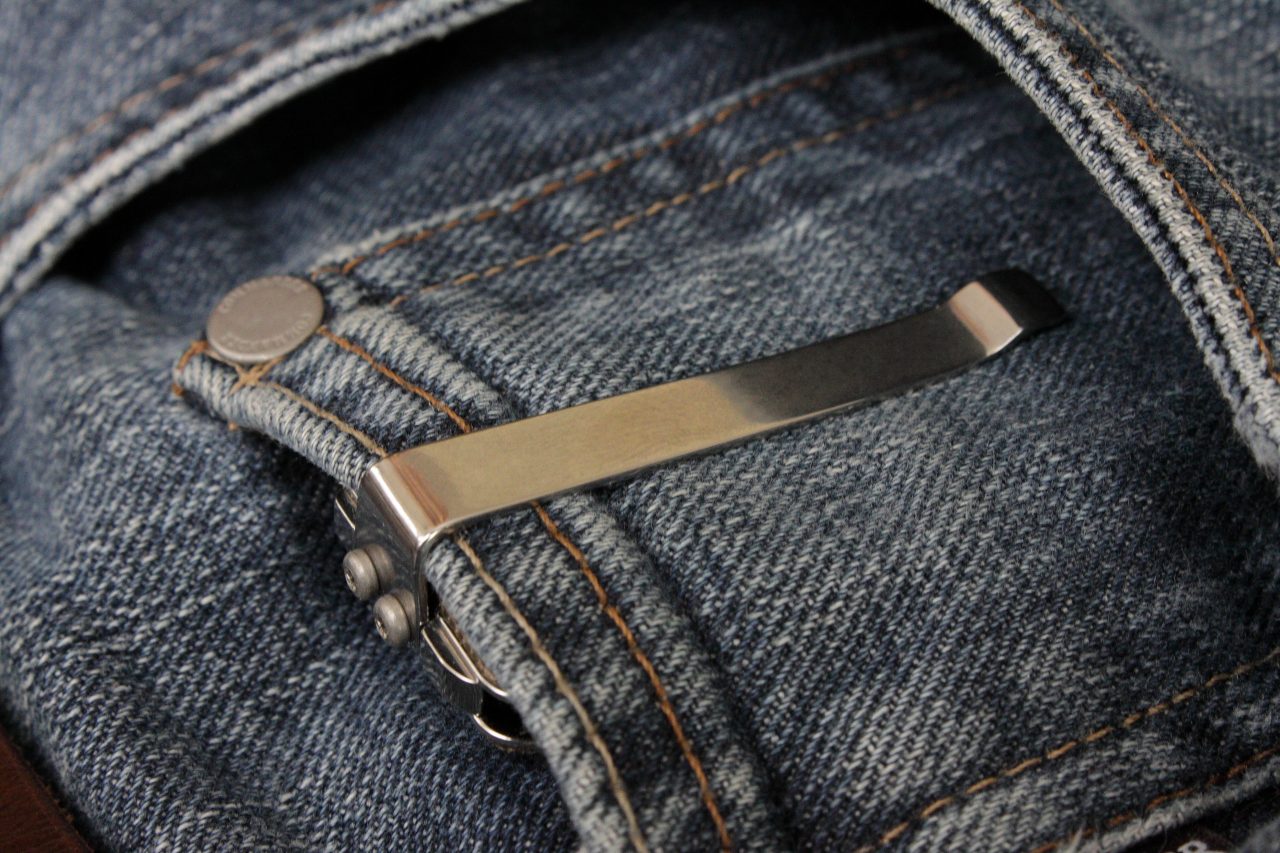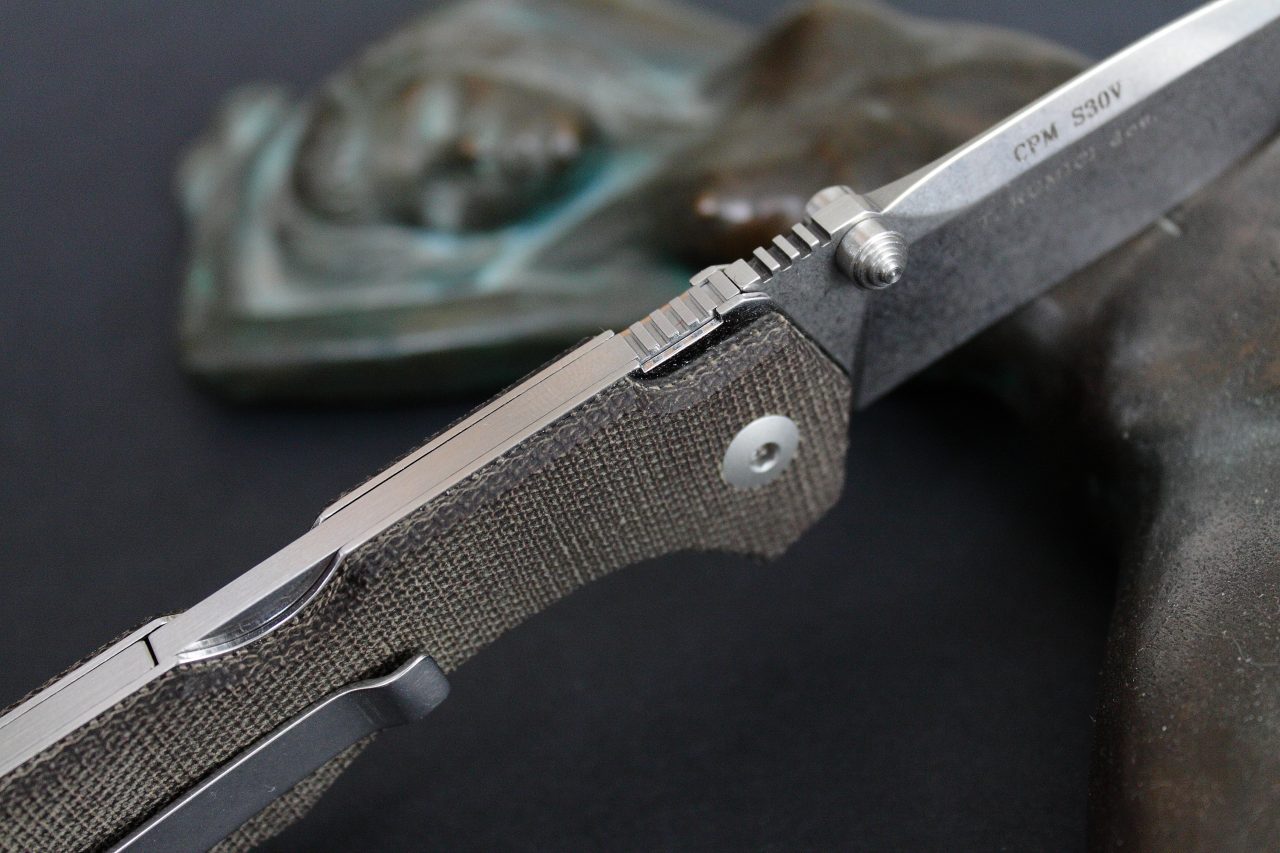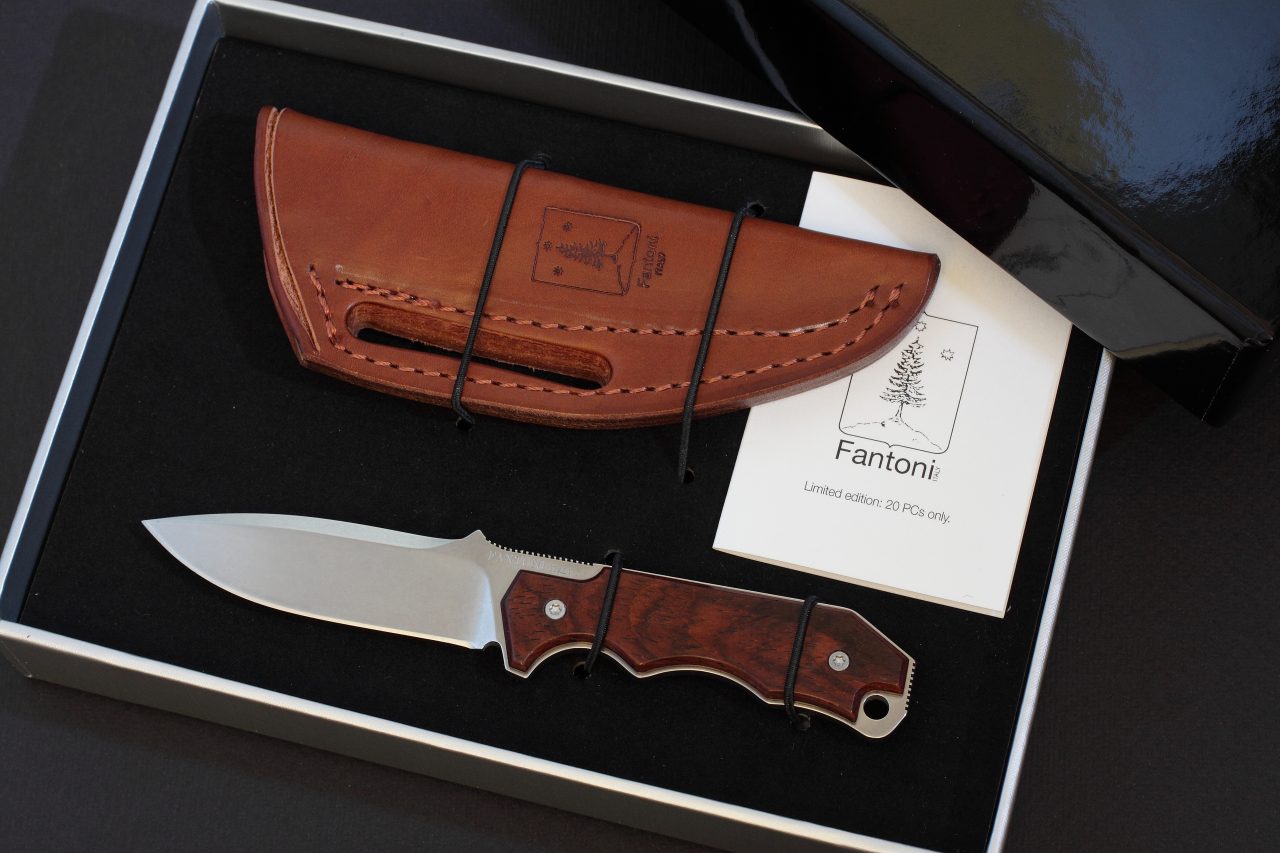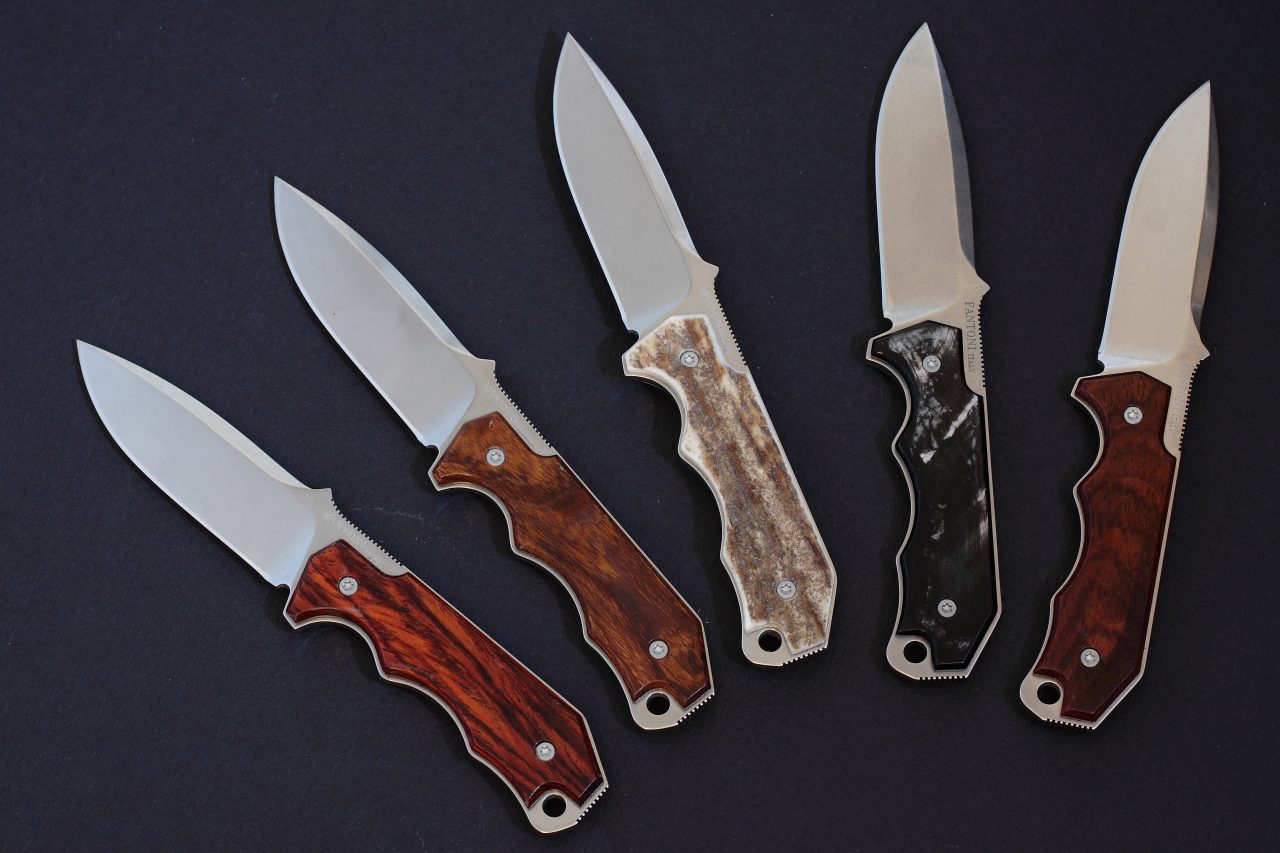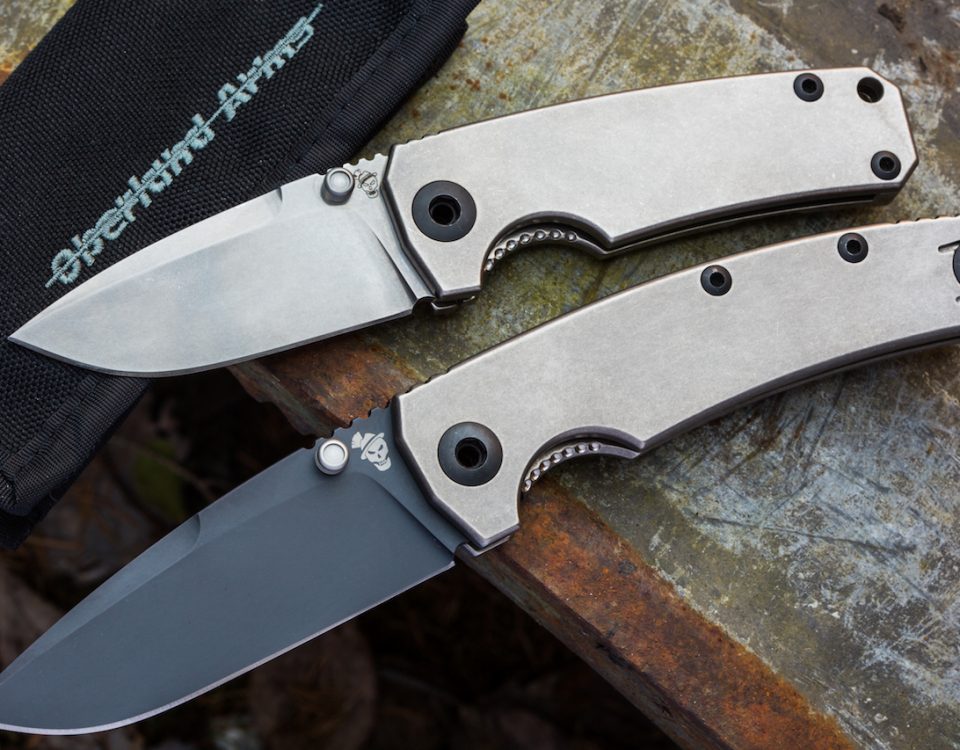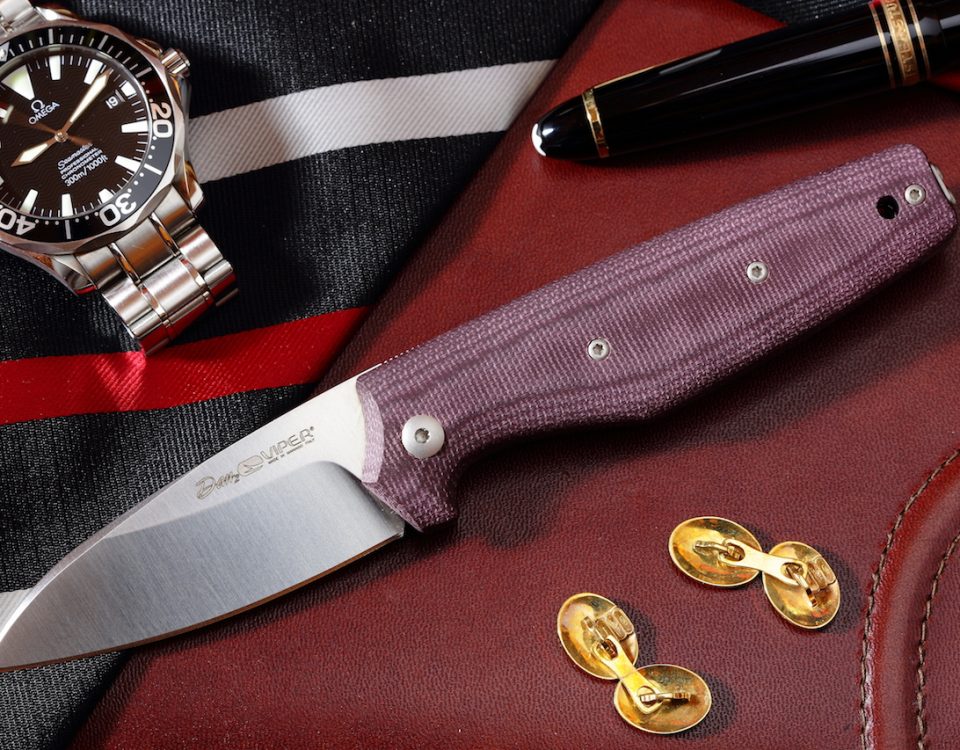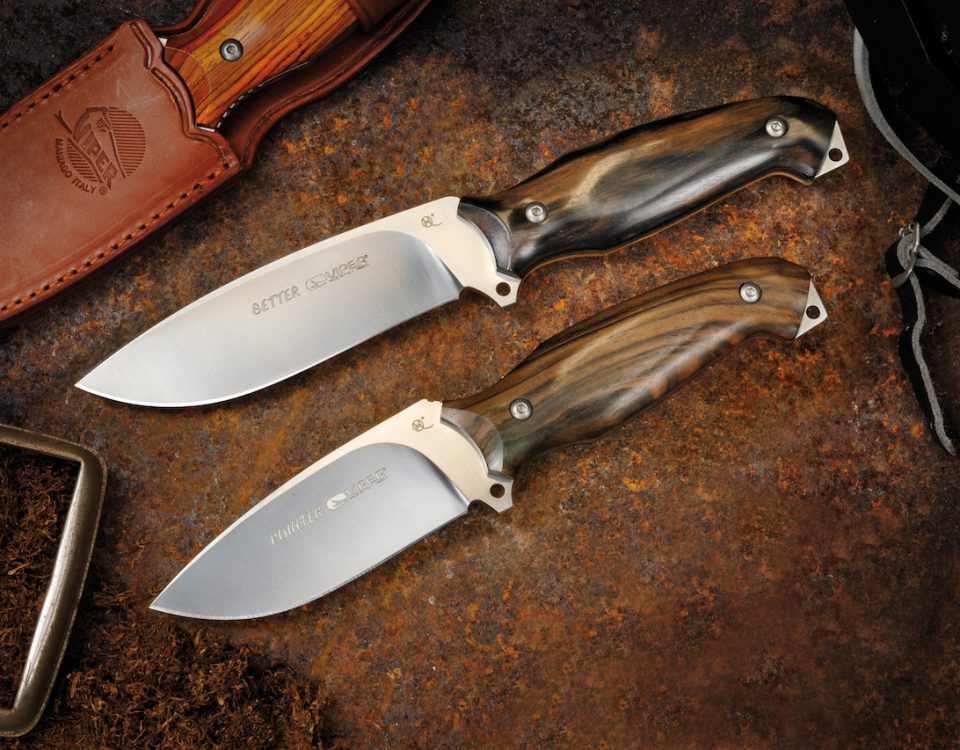The HIDE, fixed and folder, share the same design except for variations due to mechanical necessities.
(photo courtesy of Knives International Review)
The initial sketches.
The wooden mockups used during the ergonomic study.
When closed the Hide folder has regular shapes, without any protrusions, so as to be as comfortable as possible when it is in your pocket.
(Photo courtesy of Knives International Review)
The clip is screwed on the back spacer. It makes the folder disappear in the pocket.
(Photo courtesy of Knives International Review)
Aiming to create an ambidextrous folder, exceedingly robust, I preferred to use a Backlock mechanism instead of a liner lock, deliberately oversized.
(Photo courtesy of Knives International Review)
All 40pcs of the limited edition were sold in a nice collector box. They were accompanied by a sheath made of high quality leather, which closely resembles those used for self-defense revolvers.
(Photo courtesy of Knives International Review)
Here we can see five handle variations proposed by Fantoni. From right to left: snake wood, buffalo horn, deer horn, ironwood and cocobolo wood.
(Photo courtesy of Kinves International Review)
Low profile
Hide was born with the idea of creating a small fixed blade that could be a real EDC alternative to a folder.
Many times the folder thickness and weight problems are no less important than the length; Furthermore the presence of a block system raises the weight and increases the number of components.
The fixed Hide, thick just eight millimeters, has small dimensions, plus the strength and lightness impossible to obtain on a folder with same overall dimensions.
To contain the maximum length the handle does not offer support for the little finger, as it usually happens on many compact pistols; despite this, thanks to the finger grips and subtle ridge knurled thumb, the handling is excellent.
The handle consists of two thin canvas micarta scales, which improve the handling possibilities giving more grip. A guard well developed avoids that fingers can slide on the edge while the upper, small in size, allows the thumb to remain free and to position itself more forward .
At the end of the handle there is a hole where you can set a lanyard paracord, facilitating the extraction and providing an handhold for the little finger.
The tang under the scales is widely lightened by a series of triangular openings to contain the overall weight in just 69 grams, without affecting the strength.
An all-rounder blade
The drop point blade is capable of adapting to a wide variety of jobs: the Hide is ideal both as EDC or as back-up for operational uses same as a carving or skinning tool for hunting.
Along with Fantoni, leading edge for exotic steels and for heat treatment, we chose to use the Crucible CPMS-30V at the time not yet widespread in Italy. Thanks to the direct contact with Crucible, the Maniago company was able to obtain the remarkable hardness of 62 HRC without sacrificing strength. Thanks to a well-kept sharpening process, the cutting qualities are exceptional, also in duration. In CATRA test it was obtained a value of 700 millimeters.
Four millimeters are a wide thickness for a knife of this size, which is therefore extremely strength. To reduce the weight the main bevels are high and concave and just before the back, they meets an aggressive counter-chamfering giving rise to a ribbing that stiffens the blade.
A thin sheath
The first Hide fixed version was accompanied by a very thin Kydex sheath: a choice less economical than the skin or synthetic yarn, but he needed to have minimum dimensions and allow versatile transport. To allow easy cleaning, the housing was made of two halves connected by easily removable round-head screws. The retention of the knife has been entrusted to two oversized hemispheric ridges, which engage in guard zone.
The dimensions are contained so that the knife, complete with sheath can fit comfortably in the front pocket of a pair of jeans.
Since this is a knife designed primarily for concealed carry, the original sheath was set up to be used with a necklace, or placed inside the pants using the metal clip included. A series of holes allowed the user to choose other types of fixing with plastic ties, lanyards or Tek-lok systems.
Today, the Hide is sold with a tighter folded ìtacoî Kydex sheath, hand made by Gianluca “Obe” Farini, with a Tek-Lok system. Alternatively the customer can chose a beautiful brown leather holster with belt loop.
Also foldable
Years later, Fantoni asked me to define a folding version of the Hide.
The task was not easy and obvious: we needed to find room for mechanisms within an extremely compact and original design. Moreover, having regard to the considerations of initial strength, was supposed to be a much more reliable closing system of the standard; that’s why I preferred an old school back lock system instead of a faster liner lock.
Despite the addition of steel layers required to support the mechanics, the weight of Hide folder is a result of just 103 grams. Surely on the market there are lighter products, but few can boast this strength: despite being a small knife, the lock lever is 3.6 mm thick and the whole mechanics is oversized for a blade of just 75 mm. that’s why we chose to use a sturdy rear spacer that supports the spring.
Having to hold the blade, the handle is a bit longer than the original fixed blade, allowing you to rest comfortably even the little finger. For this reason the finger grooves were completely revised in the drawing. The thumb rests on a dedicated checkering or can advance along the back depending on the task to be performed. As for the fixed, even the standard version of the folding knife has two thin scales, offering a good grip and a comfortable grip.
The blade is opened by pressing with the thumb on the peg Ambidextrous, characterized by concentric drawings, and once in place stops with a vigorous and reassuring sound. To unlock, press the lever on the bottom to prevent accidental closure.
You can carry the Hide folder with the reversible stainless steel clip fastened to the rear spacer. Unlike most of the clips on the market, the Hide offers a deep pocket clip, shaped to make disappear completely the knife in his pocket, keeping intact the spirit of the original project pursuing the utmost discretion. Those wishing to make easier the extraction may set a loop into the appropriate hole. As the fixed one, the folding the Hide is characterized by dimensions and weight, making it perfect for daily carry, also in town: when closed is flat and with regular shapes, which help the convenience of carry and prevent entanglements. In addition, the entire knife is ambidextrous, from opening to clip.
Production and variations
Initially, the fixed Hide came out in a numbered limited edition of 40pcs, created exclusively for the Italian shop Coltelleria Collini: 20pcs with a satin blade and 20pcs with black PVD blade. Each knife was contained in a collector’s box and offered with a pair of Micarta scales and with a spare pair of ebony wood scales.
Later came the standard series with black PVD coating or with a stonewashed finish; both with green canvas Micarta scales.
Over the years Fantoni has made numerous variants of the fixed and folding Hide with different scales like many essences of wood, horn, deer, G10 or carbon fiber. Some with flat bevels and a reduced blade thickness.
For countries where it is illegal to carry knives with quick opening systems was performed a special peg-free version of the folding Hide.
Specifications
Manifacturer: Fantoni
Web: www.fantoniknife.com
Model name: Hide – Hide folder
Blade material: CPM S30V 61-62 HRC
Handle material: Micarta
Lenght: 168 mm – 180 mm
Blade Lenght: 80 mm – 76 mm
Blade thickness: 4 mm – 3,2 mm
Weight: 68 g – 107 g
Locking system: back lock
Sheath (fixed model only): Kydex or leather
CPM S30V Data sheets http://www.crucible.com/PDFs/DataSheets2010/dsS30Vv1%202010.pdf

